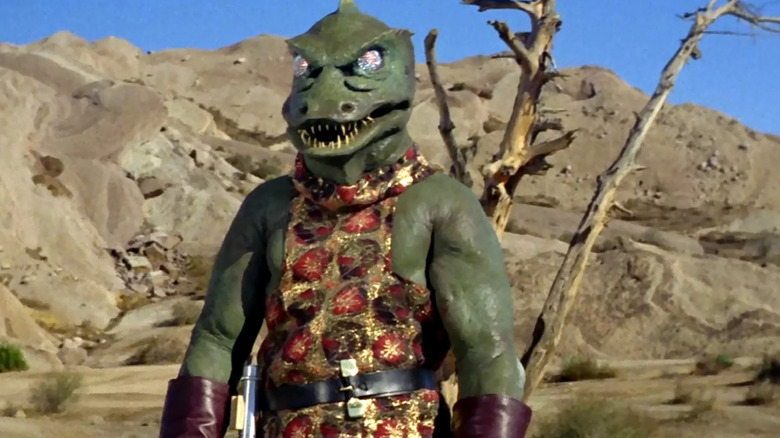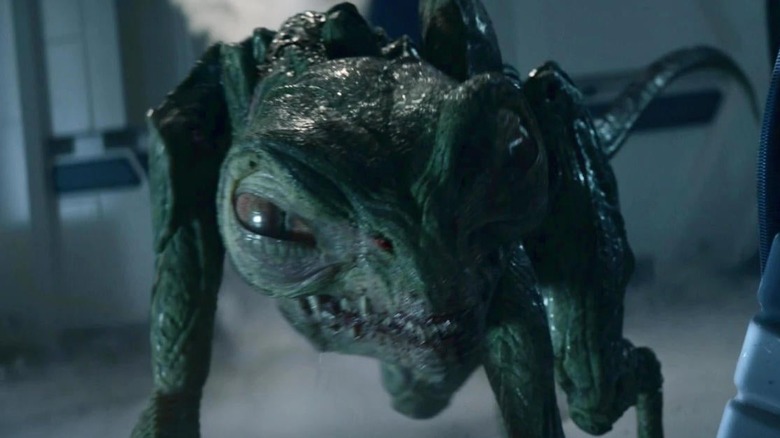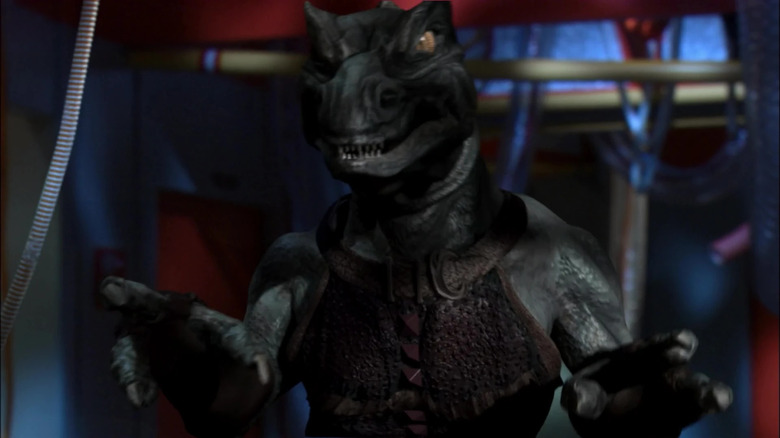How Star Trek: Strange New Worlds Brought The Gorn To Life
"Star Trek: Strange New Worlds" features the third television appearance of the reptilian Gorn. It also marks the development of the third method used to bring the scary lizards to life.
The original Gorn, the villain of the classic "Star Trek" episode "Arena," was portrayed by stuntmen Bobby Clark and Gary Combs. The pair wore a rubber get-up designed by Wah Chang. When the Gorn reappeared almost 40 years later in the "Star Trek: Enterprise" episode "In a Mirror Darkly," the crew used CGI and motion capture instead. In "Strange New Worlds," the crew combined practical and digital effects, using puppetry and CGI in tandem.
Puppeteering the Gorn
The Gorn appear onscreen in episode 9, "All Those Who Wander." These Gorn are mere hatchlings, running on all fours instead of being bipedal like the previous Gorn. Given the difference in appearance, it makes sense that the crew had to find a new way to bring them to life. In a behind-the-scenes feature "The Gorn Reborn," the cast and crew discuss the process of creating the effects and what it was like filming with them.
The Gorn puppets were the work of the team at Legacy Effects, led by Alan Scott, and "Strange New Worlds" in-house prosthetics team, led by Chris Bridges. Rebecca Romijn (Commander Una-Chin Riley) said:
"Practical effects are always more interesting. They're more interesting to play with on set and they're more interesting to watch, I think."
This doesn't mean going practical was without challenges. Producer Alex Kurtzmann said:
"Puppetry is very tricky because the best versions of it have to include incredibly specific lighting, otherwise you're very aware you're looking at a puppet."
Bridges himself added:
"Traditionally, there hasn't been a lot of animatronics or puppeted characters. I think that's because when you're shooting on main unit, it's so fast-paced. And puppeteering something in real time can get quite intricate ... I think we demonstrated that [puppetry] is viable and that we would probably see a lot more of it."
The feature shows how a particularly frightening scene, where the alpha hatchling gnaws on a window to get to Nurse Chapel (Jess Bush), was really just a hand puppet. I, for one, never would've guessed, so the crew clearly did something right.
CGI touch-ups
Despite the impressive practical effects, they alone didn't carry the episode. Visual effects supervisor Alexander Wood discussed how the team used CGI to hide signs of the Gorn's puppeteering and increase their expressiveness.
In particular, the scene where the Gorn hatchlings erupt out of an unnamed alien (its costume also the work of Chris Bridges' team). The minuscule Gorn newborns were puppets too, held on rods; the rods obviously had to be removed with digital touch-ups. Wood also spoke of how the VFX team added micro-movements to the Gorn that made them look more alive, like head twitches, "the very little subtle things that go from puppet to a very realistic-looking alien."
CGI and practical effects are often discussed in competition with each other, but "Star Trek: Strange New Worlds" proved how the two can be used together. At the end of the day, both types of effects are tools. Practical is better for some jobs, and VFX better for others; it's the filmmaker's job to know which situation calls for which.


